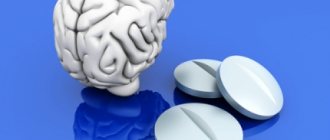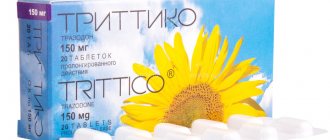N. B. Zharkova, G. I. Kopeiko, A. A. Mukhin NCPZ RAMS, Moscow
Psychiatry and psychopharmacotherapy :: N1/1999
Clopixol (zuclopenthixol), which has rightfully become a classic first-line antipsychotic for foreign specialists, is one of the newest and least studied drugs for most domestic psychiatrists. At the same time, there is great interest in both the peculiar spectrum of psychotropic activity of Clopixol, which combines a pronounced antipsychotic effect with a transient sedative and specific inhibitory effect, and the existence of various dosage forms of the drug, among which, along with the already familiar tablets and depot injections, there is a unique one that does not have analogues injectable form with a three-day effect (Clopixol-Acufaz).
Zuclopenthixol is a powerful antipsychotic drug from the thioxanthene group containing a piperazine side chain. Zuclopentixol is a cis-isomer of clopentixol and, as an active molecule, is included in all dosage forms of the drug Clopixol.
The primary antipsychotic activity of zuclopenthixol, like most antipsychotic drugs, can be explained by a high degree of affinity for dopamine D2 receptors. In addition, a relatively high degree of affinity of zuclopenthixol for dopamine D1 receptors was revealed, which probably determines the low severity of extrapyramidal disorders. The affinity of zuclopenthixol for serotonin 5-HT2 receptors and α1 adrenergic receptors was also discovered.
In our opinion, the availability of a wide range of different dosage forms of the neuroleptic zuclopenthixol is an important advantage, since it opens up new therapeutic possibilities, allowing the combination of different doses, intervals and methods of drug administration in the same patient. In addition to this, the monotherapy method significantly increases the effectiveness and safety of treatment by eliminating the possibility of mutual inhibition or potentiation of drugs and their metabolites.
It is well known that at various stages of mental illness, the requirements for the selection of therapy are determined by the characteristics of a particular condition. As clinical experience shows, the optimal method of treating acute psychotic conditions may be the administration of intramuscular injections of aqueous solutions of high-potency neuroleptics. This method ensures the achievement of a rapid therapeutic effect by eliminating the hepatic metabolism phase, and also creates an optimal drug dose control regimen. Unfortunately, the administration of frequent intramuscular injections in the first days of a patient’s stay in a psychiatric clinic often leads to serious difficulties in the patient’s relationship with the medical staff, and also causes the formation of painful infiltrates at the injection site. In this situation, the advantages of the dosage form of the drug (Clopixol - Akufaz) with a fairly rapid development of sedative and antipsychotic effects, but allowing less frequent administration, are undoubted.
Research shows that about 50% of patients with schizophrenia do not take prescribed treatment, which leads to a decrease in its effectiveness and an increased risk of relapse. One of the latest works on this problem provides more pessimistic figures: about 80% of patients with schizophrenia actually do not take medications. In this regard, the advantage of using depot antipsychotics, in particular Clopixol Depot, is obvious and is associated with the convenience of administration (once every 2-4 weeks), guaranteed entry of the antipsychotic into the patient’s body, reducing the risk of drug overdose when used independently by the patient, as well as reducing the total dose of the drug, since when using depot antipsychotics there is no phase of hepatic metabolism. The last circumstance, i.e. reducing the total dose of the drug leads to less severe side effects.
The use of depot drugs provides the most stable level of the active drug in the blood serum and a more predictable antipsychotic effect. In addition, the use of depot antipsychotics contributes to better socialization of patients, because eliminates the need to regularly take medication during work hours, which may be undesirable or inconvenient for patients.
It seems quite logical to present the literature data on the use of various dosage forms of Clopixol in the distribution along the “length” of the disease, ranging from the most acute and severe conditions (manifestation, exacerbation of psychosis), requiring active therapeutic intervention, to milder ones (establishment of remission, remission, mildly occurring processes) where maintenance therapy is necessary.
Clopixol tablets (zuclopenthixol hydrochloride) - oral form
This form of the drug has a much longer history of use than Clopixol Akufaz and is widely used throughout the world for the treatment of schizophrenia and other mental illnesses.
To date, a large amount of information has been accumulated on the experience of using zuclopenthixol tablets in the treatment of acute psychoses, exacerbations of chronic psychoses and acute manic states. Many direct and comparative, including double-blind, tests of this drug have been carried out, confirming its high therapeutic effectiveness, comparable to the effectiveness of haloperidol and chlorpromazine.
In the UK, a multicentre study compared, using a double-blind method, the effect of tablet forms of Clopixol and chlorpromazine in acute psychoses (schizophrenia and schizoaffective psychoses). The study included patients aged 18 to 65 years who began receiving Clopixol 25–150 mg/day (average 75 mg/day) or chlorpromazine 100–600 mg/day. Starting from the second week of treatment in most patients, without compromising the therapeutic effect, the daily dose of Clopixol was reduced to 50 mg. Chlorpromazine was used mainly at a dose of 600 mg/day throughout the study (10 weeks). Both drugs showed high antipsychotic activity. According to this indicator, there was a tendency towards an advantage of Clopixol, but it did not reach the level of statistical significance.
Another multicenter study compared the effects of tablet forms of Clopixol and haloperidol on acute psychosis using a double-blind method. The average daily dose of clopixol was 33.5 mg, haloperidol - 10.3 mg. Both drugs showed equally high therapeutic activity, however, patients taking Clopixol were discharged from the psychiatric hospital earlier, which reflected the more rapid development of the antipsychotic effect of Clopixol compared to haloperidol. Clopixol caused a significantly more pronounced reduction in the anxiety-depressive component of psychosis than haloperidol. In addition, extrapyramidal symptoms in those taking Clopixol were, as a rule, transient, while in patients receiving haloperidol they were almost permanent.
Significant improvement while taking Clopixol tablets was observed in 69 - 87% of patients with acute and subacute manic conditions. A significant reduction in the acute manifestations of manic disorder was observed according to various data during the first 1 to 4 weeks of therapy. In some studies, in some of the most severe cases, treatment of the acute condition began with the use of Clopixol Acufase for the first 3 to 6 days of treatment, and then continued with Clopixol tablets. It is important to note that the use of high doses (up to 130 - 150 mg/day) was not more effective than the use of medium therapeutic doses for mania (20 - 50 mg/day). About 80% of patients received the drug at a dose of 20 - 30 mg/day, and increasing the dosage above 50 mg/day did not increase the effectiveness of therapy, but only led to an increase in the severity of side effects. Most researchers have concluded that, with a good therapeutic effect, dose reduction can begin on average 2 weeks after the start of treatment without the risk of exacerbation. It has been suggested that the treatment of mania requires slightly lower doses than for the treatment of schizophrenia.
The use of Clopixol for agitation and aggressiveness in the elderly is of particular interest. Clopixol was compared in a double-blind manner with thioridazine and the combination of haloperidol and levomepromazine. Both studies were conducted in Scandinavia and were multicenter. The first of them included inpatient dementia patients (mainly with Alzheimer's disease) aged 64 to 97 years. Their mental state was characterized by “the presence of restlessness, hostility, as well as accompanying anxiety, confusion, irritability, insomnia, delusions, hallucinations, hypochondria, and screams.” A higher effectiveness of Clopixol on insomnia was found (the difference between the drugs is statistically significant). Side effects of Clopixol occurred rarely, their severity was insignificant, and no serious adverse effects on the cardiovascular system associated with the drug were observed.
A patient population similar in demographic and clinical characteristics was used to compare Clopixol tablets with a combination of haloperidol and levomepromazine (tizercin, nozinan). The study lasted 4 weeks. The starting dose for Clopixol was 4 mg (one 2 mg tablet twice a day). In another group of patients, 1 mg of haloperidol was prescribed in the morning and 5 mg of levomepromazine in the evening. The average daily drug doses at the end of the study were slightly higher: 4.8 mg clopixol; 1.6 mg haloperidol + 7.6 mg levomepromazine. The authors concluded that for the treatment of aggression and agitation in the elderly, it is preferable to use Clopixol tablets because it acts faster and allows monotherapy.
It should be noted that, in accordance with the average dosages used for a particular mental pathology, tablets of different dosages are produced: 2, 10 and 25 mg, which makes the use of the drug more convenient.
Thus, literature data indicate that Clopixol tablets can be successfully used both in the treatment of acute and subacute psychoses, including acute manic states, and in the treatment of agitation and aggressiveness in the elderly, as well as for the correction of behavioral disorders in persons with intellectual disabilities .
Similar drugs:
- Eglonil Oral tablets
- Finlepsin Oral tablets
- Moditen depo Solution for intramuscular administration
- Egolanza Oral tablets
- Rispaksol Oral tablets
- Thiodazine Oral tablets
- Closasten (Closastene) Oral tablets
- Thioridazine Oral tablets
- Leponex Oral tablets
- Risperidone Oral tablets
** The Drug Directory is intended for informational purposes only. For more complete information, please refer to the manufacturer's instructions. Do not self-medicate; Before starting to use the drug Clopixol Depot, you should consult a doctor. EUROLAB is not responsible for the consequences caused by the use of information posted on the portal. Any information on the site does not replace medical advice and cannot serve as a guarantee of the positive effect of the drug.
Are you interested in the drug Clopixol Depot? Do you want to know more detailed information or do you need a doctor's examination? Or do you need an inspection? You can make an appointment with a doctor - the Euro lab is always at your service! The best doctors will examine you, advise you, provide the necessary assistance and make a diagnosis. You can also call a doctor at home . Euro lab clinic is open for you around the clock.
** Attention! The information presented in this medication guide is intended for medical professionals and should not be used as a basis for self-medication. The description of the drug Clopixol Depot is provided for informational purposes and is not intended for prescribing treatment without the participation of a doctor. Patients need to consult a specialist!
If you are interested in any other drugs and medications, their descriptions and instructions for use, information about the composition and form of release, indications for use and side effects, methods of use, prices and reviews of drugs, or you have any other questions and suggestions - write to us, we will definitely try to help you.
Co-injection of Clopixol Akufase and Clopixol Depot
A significant proportion of patients with exacerbation of chronic psychosis (most often schizophrenia), which is relieved by Clopixol Akufaz, then require long-term maintenance treatment. Taking into account the pharmacokinetic characteristics and features of the clinical action of Clopixol Akufase and Clopixol Depot, their joint administration in one syringe seems logical. Relief of acute manifestations of psychosis is carried out by Clopixol Akufaz, and by the time its effect wears off (4-5 days), Clopixol Depot begins to act.
The theoretical premises for the use of co-injection have been tested in clinical studies. A total of 22 patients with exacerbation of psychosis (18 of them with schizophrenia) participated in these studies. In most cases, the first co-injection consisted of 100 mg Clopixol Acufase and 200 mg Clopixol Depot. The duration of the first study was limited to 2 weeks; all patients received only one co-injection. A significant reduction in psychopathological disorders was observed, which was reflected in a decrease in rating scale scores 1 and 2 weeks after co-injection, i.e. We were talking about a continuous 2-week therapeutic effect on psychosis. The protocol of the second study (10 patients with schizophrenia participated) was more complex; additional injections of Clopixol Akufaz (50 - 150 mg each) were allowed on days 3 or 7 after co-injection; repeated injections of Clopixol Depot were given 14 and 28 days after co-injection. (200 - 350 mg). A marked improvement in condition was recorded already on day 3 after the start of treatment (25% decrease in total BPRS score, p < 0.001). Subsequently, the condition continued to improve; by the end of 4 weeks, the reduction in the total BPRS score was more than 50%. Data on the side effects of such neuroleptic treatment are of considerable interest. The authors of the work concluded that, in general, side effects were quite rare, and their severity, as a rule, was not significant. In one of the patients, on the second day after co-injection, acute dystonic reactions were observed, which required parenteral administration of antiparkinsonian drugs. In another case, dystonia, rigidity, hypokinesia, and orthostatic dizziness were noted. One of the patients developed moderate orthostatic dizziness on day 14 after the start of treatment. With the use of correctors, side effects disappeared completely; in none of the cases did they lead to discontinuation of Clopixol therapy. After the research, the method of treating psychosis with co-injection began to be routinely used in a number of foreign psychiatric clinics.
Solution for intramuscular administration Clopixol Depot
Instructions for medical use of the drug
Description of pharmacological action
Antipsychotic drug (neuroleptic), thioxanthene derivative. It is believed that the antipsychotic effect of zuclopenthixol is due to the blockade of dopamine receptors in the central nervous system. Thioxanthene derivatives have a high affinity for dopamine D1 and D2 receptors. Zuclopenthixol causes rapid, transient, dose-dependent sedation before the development of antipsychotic action. Unlike zuclopenthixol hydrochloride, zuclopenthixol acetate has a longer duration of action - 2-3 days, and zuclopenthixol decanoate is a depot form and its effect lasts for 2-4 weeks.
Indications for use
Acute and chronic schizophrenia and other psychotic disorders, especially with hallucinations, paranoid delusions, and thinking disorders; state of agitation, increased anxiety, hostility, aggressiveness (supportive therapy).
Release form
solution for intramuscular administration, oily 200 mg/ml; 1 ml ampoule with needle(s), box(s) 10; solution for intramuscular administration, oily 500 mg/ml; 1 ml ampoule with needle(s), box(s) 5; solution for intramuscular administration, oily 200 mg/ml; 1 ml ampoule with needle(s), box(s) 1; Composition: 1 ml of injection solution contains zuclopenthixol decanoate (in Viscoleo vegetable oil) 200 mg; per package 1 or 10 ampoules of 1 ml. 1 ml solution for injection - 500 mg; per package 5 ampoules of 1 ml.
Pharmacodynamics
Antipsychotic drug (neuroleptic), thioxanthene derivative. It is believed that the antipsychotic effect of zuclopenthixol is due to the blockade of dopamine receptors in the central nervous system. Thioxanthene derivatives have a high affinity for dopamine D1 and D2 receptors. Zuclopenthixol causes rapid, transient, dose-dependent sedation before the development of antipsychotic action. Unlike zuclopenthixol hydrochloride, zuclopenthixol acetate has a longer duration of action - 2-3 days, and zuclopenthixol decanoate is a depot form and its effect lasts for 2-4 weeks.
Pharmacokinetics
After oral administration, zuclopenthixol is rapidly absorbed from the gastrointestinal tract. Cmax in blood plasma is achieved after 3-6 hours. Biological T1/2 is about 24 hours. After intramuscular administration in the form of a depot form, Cmax in blood plasma is achieved after 36 hours. 3 days after injection the level is approximately 1/3 from the maximum. Zuclopenthixol is distributed throughout the body, with higher concentrations being created in the liver, lungs, intestines and kidneys, and lower concentrations in the heart, spleen, brain and blood. Vd is 20 l/kg. Plasma protein binding 98%. Penetrates the placental barrier and is excreted in breast milk. Zuclopenthixol is metabolized by sulfonic acidification, N-dealkylation and glucuronidation. Metabolites do not have psychopharmacological activity. It is excreted mainly in feces in the form of unchanged substance and N-dealkylated metabolite.
Use during pregnancy
Contraindicated. Nursing mothers should stop breastfeeding.
Contraindications for use
Acute poisoning with alcohol, barbiturates, opiates; comatose states.
Side effects
Possible extrapyramidal disorders, tardive dyskinesia, neuroleptic malignant syndrome, drowsiness, dizziness, dry mouth, impaired accommodation, urinary retention, constipation, tachycardia, orthostatic hypotension, changes in liver function tests.
Directions for use and doses
IM, in the upper outer quadrant of the gluteal region. The dosage and interval between injections are determined individually, in accordance with the patient’s condition. Clopixol Depot 200 mg/ml: for maintenance therapy, 200–400 mg (1–2 ml) is usually prescribed every 2–4 weeks; if necessary, in higher doses or at shorter intervals; when the solution volume (200 mg/ml) is more than 2–3 ml, it is preferable to use a solution of higher concentration (500 mg/ml). Clopixol Depot 500 mg/ml: usually administered 250–750 mg (0.5–1.5 ml) every 1–4 weeks. When switching from oral Clopixol to Clopixol Depot, the oral daily dose (in mg) is multiplied by 8. The dose is administered intramuscularly once every 2 weeks; During the first week, oral administration should be continued, but at a reduced dosage. When switching from Clopixol-Acupaz, 200-400 mg (1-2 ml) of Clopixol Depot are prescribed simultaneously with the last injection of the drug, repeated injections - once every 2 weeks; if necessary, increase the dose or shorten the interval between administrations.
Interactions with other drugs
Enhances the effect of alcohol, barbiturates and other central nervous system depressants, and reduces the effect of levodopa and other adrenergic substances. Weakens the hypotensive effect of guanethidine and its analogues. The risk of developing extrapyramidal disorders is increased by metoclopramide and piperazine. Can be mixed with Clopixol-Acufaz (co-injection).
Precautions for use
Prescribed with extreme caution for convulsive syndrome, chronic hepatitis, cardiovascular diseases; persons driving a car or other machinery. With long-term therapy, especially in large doses, careful monitoring of the patient's condition is necessary.
Storage conditions
List B: In a place protected from light, at a temperature not exceeding 25 °C.
Best before date
36 months
ATX classification:
N Nervous system
N05 Psycholeptics
N05A Antipsychotic drugs
N05AF Thioxanthene derivatives
N05AF05 Zuclopenthixol




